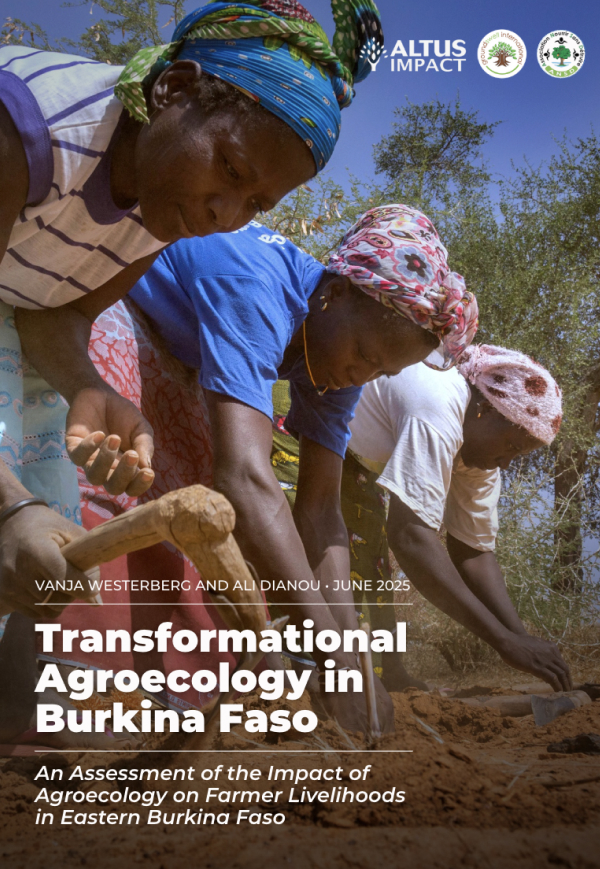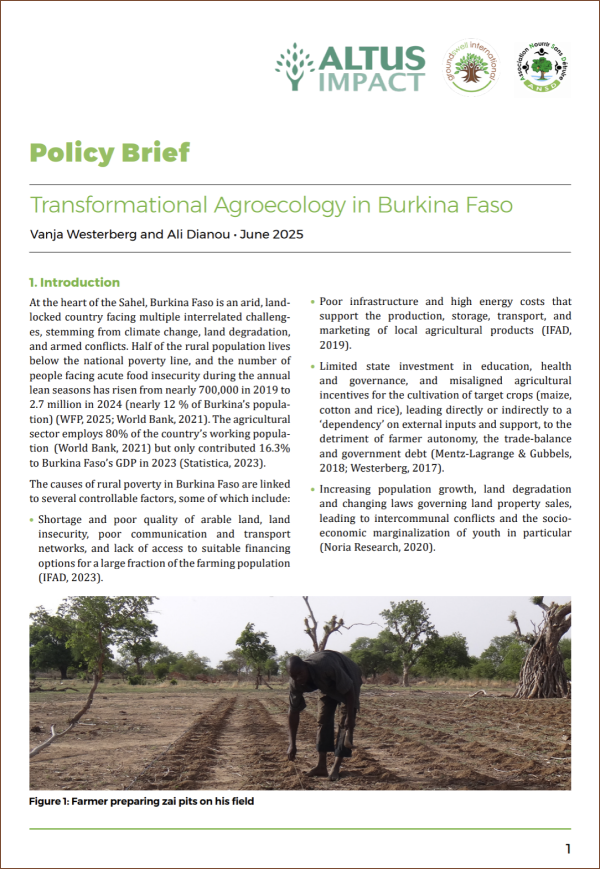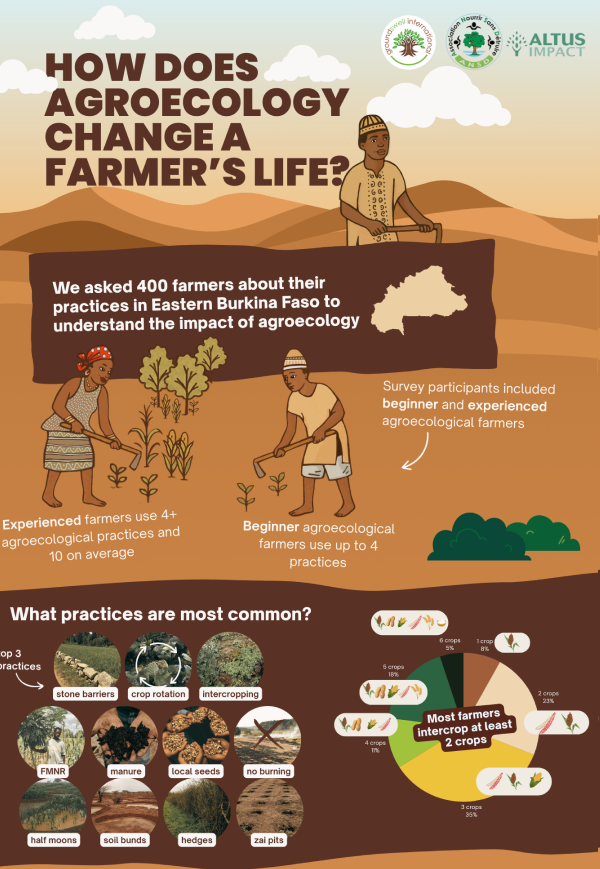Agroecology Pays Off in Burkina Faso: New Study Shows 77% Yield Gains and Strong Financial Returns Despite Extremely Dry Conditions
New study demonstrates that supporting and investing in farmer-led agroecology improves resilience, yields, income, and wellbeing, even during one of Burkina Faso’s driest years on record.
A new study from Groundswell International, Altus Impact, and the Burkinabè NGO Association Nourrir Sans Détruire (ANSD) offers compelling evidence that agroecology works and is ready to scale.
The study analyzes data from more than 400 farming households in Burkina Faso’s eastern region, collected between June 2023 and June 2024. The results show a clear progression: as farmers adopt more agroecological practices, their incomes, yields and wellbeing improve.
Indeed, farmers using several agroecological practices such as zai pits, stone barriers, and Farmer-Managed Natural Regeneration of trees (FMNR) achieved 77% higher yields and 67% higher net incomes than those using few or none, even during one of the driest years in recent history. This suggests strong potential to expand adoption and contribute to national food sovereignty with support from national policies and civil society.
These results reflect ANSD’s long-term fieldwork to strengthen community-led agroecology. Since launching its work in Burkina Faso’s Eastern region in 2011, ANSD has promoted agroecology through a farmer-to-farmer model of innovation and knowledge sharing. Before ANSD’s intervention, agroecological practices were rare; today, adoption has become widespread, driven by organized community learning and experimentation.
“We have supported nearly 89 communities in eastern Burkina Faso to organize their own Agroecology Committees, which take the lead on organizing farmers to experiment with agroecological practices and then spread them farmer-to-farmer,” said Ali Dianou, co-author of the study and ANSD’s Executive Director. “Agroecology requires strengthening farmers’ organizations to test and spread technical and economic alternatives. Farmers co-creating knowledge allows communities to create a real pathway out of rural poverty, food insecurity, and environmental degradation.”
ⓘ The study defines advanced agroecological farmers as those who consistently apply at least four high-impact practices adapted to the local context, such as zai pits, half-moons, stone contour barriers, FMNR, and legume-cereal intercropping. These farmers represent around 25% of the population in the study area. The comparison group consists of farmers only beginning to adopt agroecology, with fewer practices in place (less than four practices).
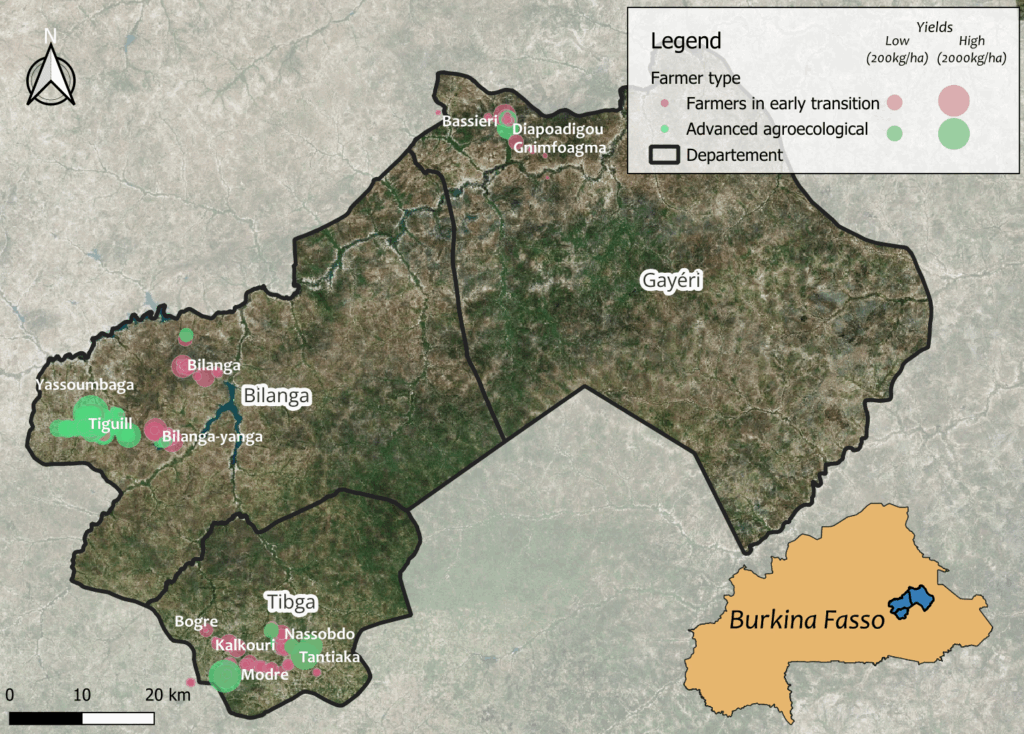
Key Findings: Agroecology’s Transformational Impact on Yields, Income, and Climate Resilience
1. Advanced agroecological farmers achieve significantly higher yields and income
- Yields were 77% higher for advanced agroecological farmers (1,230 kg/ha), nearly double that of farmers beginning their transition (695 kg/ha) during the 2023 growing season.
- The most advanced agroecological systems had 4.4x higher yields (340% increase from 320 to 1,420 kg/ha) compared to farmers using no agroecological practices, demonstrating the full potential of agroecological transition.
- Net income per hectare was 67% higher for advanced agroecological farmers ($489/ha) compared to farmers in early transition phases to agroecology ($293/ha).
- These results represent significant improvements in human wellbeing in a context where GDP per capita is only US$ 739 (in 2023).
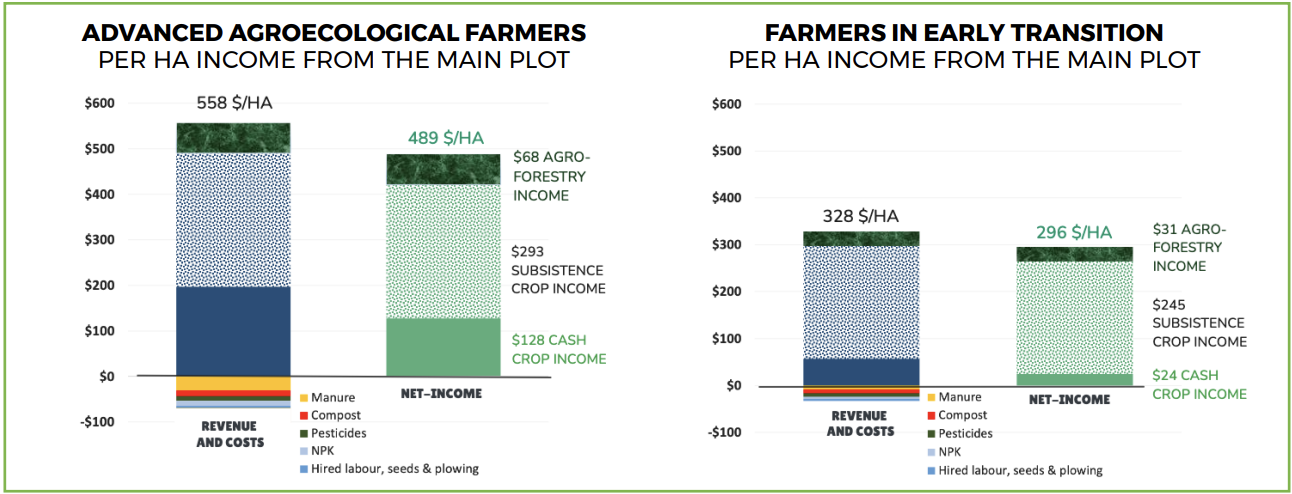
2. Agroecology builds resilience under climate stress
- In 2023, farmers faced extremely dry conditions, with cumulative rainfall at just 300 mm, well below the 420 mm average (1981–2020).
- Despite this, advanced agroecological farmers maintained robust yields. Satellite data reveal they have higher drought resilience, improved soil health, and increased land productivity, relative to farmers in early transition to agroecology.
- The total food stock of advanced agroecological farmers at the time of the study was triple that of farmers in early transition.
3. Agroecology outperforms chemical input use
- The study reveals that chemical fertilizers and pesticides provided no measurable yield increase in the study area and that herbicides had a slight positive impact on yields, but only at very low dosage levels. In contrast, agroecological practices consistently improved outcomes even under significant water stress.
- The table below provides selected examples of how different practices impact yields.

This figure shows how stacking agroecological practices can increase yields for farmers by 340%.
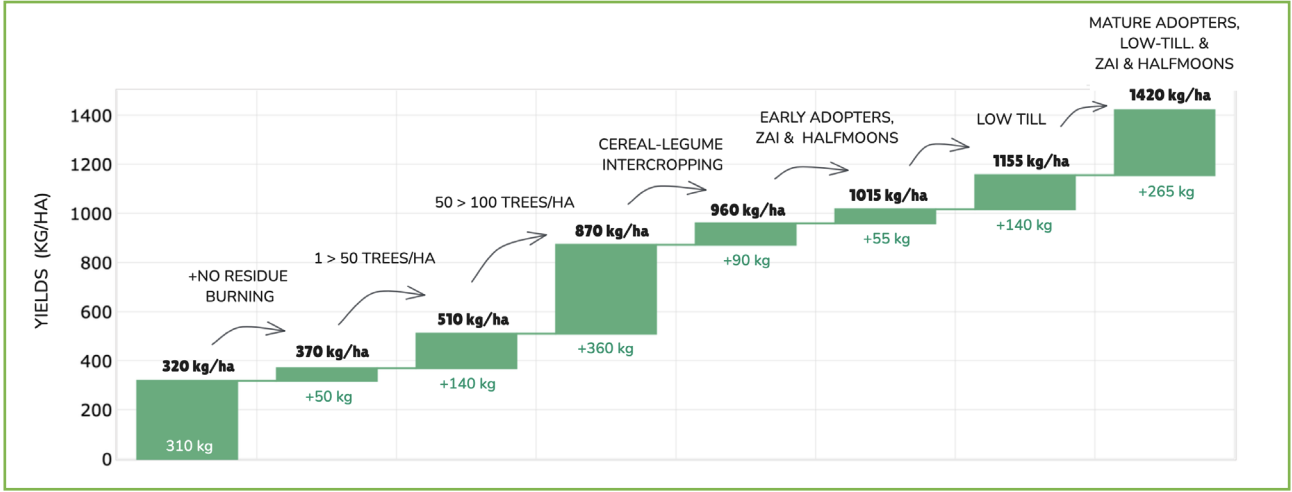
4. Advanced agroecology helps farmers reach and surpass a Living Income
The study demonstrated that farming households practicing advanced agroecology earned 40% more than the Living Income benchmark for rural Burkina Faso ($2,951 vs. $2,112), while early-transition farmers fell $781 below the benchmark.
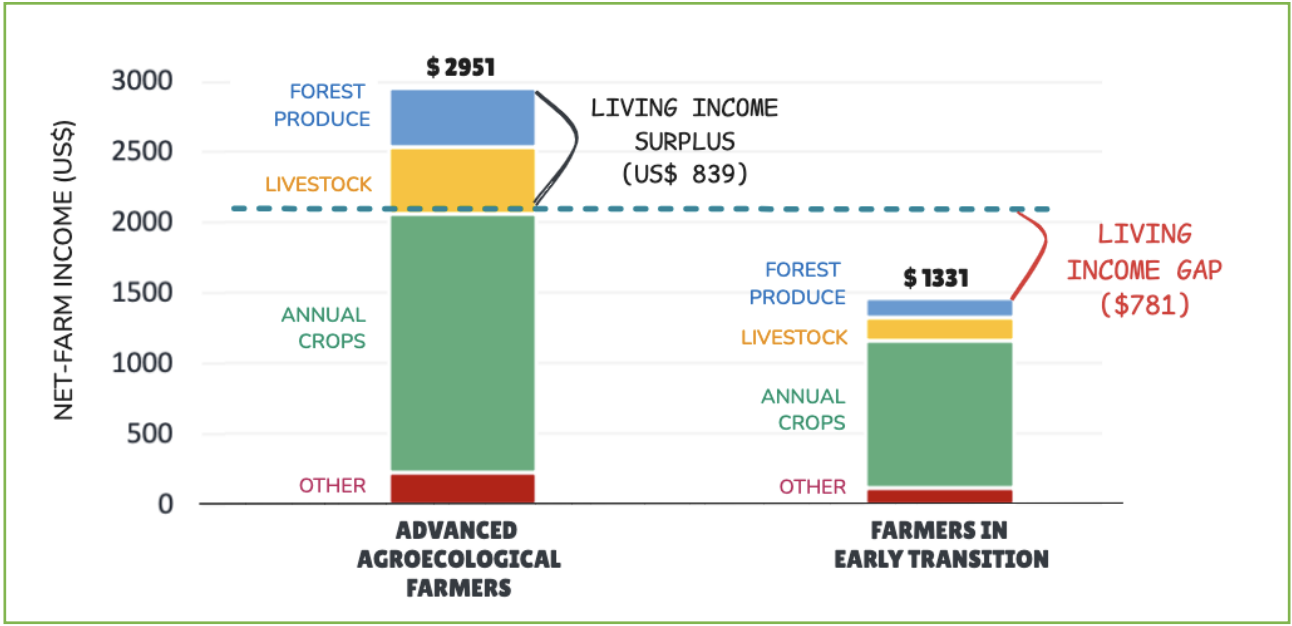
farmers in early transition
ⓘ The benchmark is developed by the Living Income Community of Practice that supports activities to improve smallholder incomes towards living incomes, defined as a decent standard of living for all household members, including food, water, housing, education, healthcare, transport, clothing, and other essential needs including provision for unexpected events.
5. Investing in farmer-led agroecology is essential for rural development and land regeneration
“We have clear evidence that scaling up farmer-led, community-driven agroecological innovation effectively addresses rural poverty and land degradation in Burkina Faso,” said Tsuamba Bourgou, West Africa Regional Coordinator for Groundswell International. “This has the potential as well to address root causes of conflicts, including poverty, lack of opportunities for young people, and competition over natural resources.”
A Strong Investment Case
A typical and popular basket of agroecological practices (zai pits, stone barriers, and FMNR) generated an impressive 43% annual return over 15 years. The pay-off period to reimburse implementation costs was only 5.4 years. With subsidies for stone barriers, the pay-off period was reduced to 4.5 years. This demonstrates that investments in agroecology, with a focus on local farmer agency, deliver high-impact and market-ready development returns.
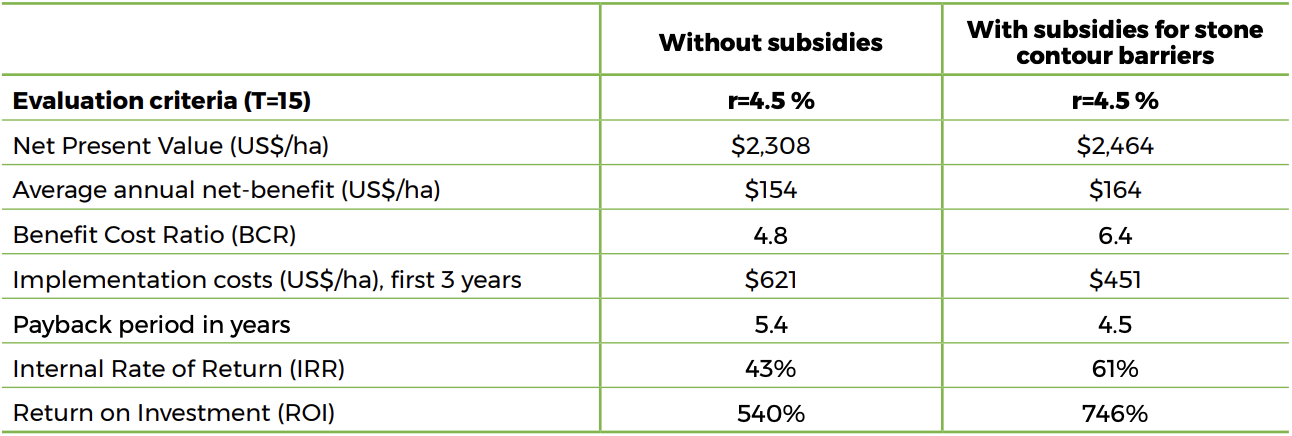
example of a ‘Zai pits, stone barrier and FMNR’ package (discount rate of 4.5%, 15 years time horizon)
“Smallholder farmers’ up-front labor and material costs can be addressed if governments and donors repurpose agricultural subsidies (currently skewed toward inorganic inputs), towards supporting agroecology, e.g. through targeted grants for adapted equipment, and blended finance mechanism that can help unlock patient capital for the many credit-worthy & investment-ready farmers in the Eastern region” said study co-author Dr Vanja Westerberg, CEO of Altus Impact and Lead Economist.
With one in four farmers in the eastern departments of Gayeri, Bilanga, and Tibga already practicing advanced agroecology on over 25,000 hectares of land thanks to ANSD’s work in collaboration with Groundswell International, the authors urge the government, donors, and investors to scale the agroecological transition. Key recommendations include:
- Repurposing agricultural subsidies currently directed at chemical inputs toward agroecological investments with proven returns.
- Supporting blended finance models such as grants, credit guarantees, and concessional loans to help farmers overcome upfront transition costs.
- Investing in appropriate tools and equipment to reduce labor barriers and make agroecology more accessible.
- Supporting local rural enterprises needed for agroecology (seed banks, biological inputs, saving and credit groups, etc.).
- Integrating agroecology into national strategies for land restoration, food security, peace building, and climate resilience, aligning with Burkina Faso’s NDCs and Sustainable Development Goals.


